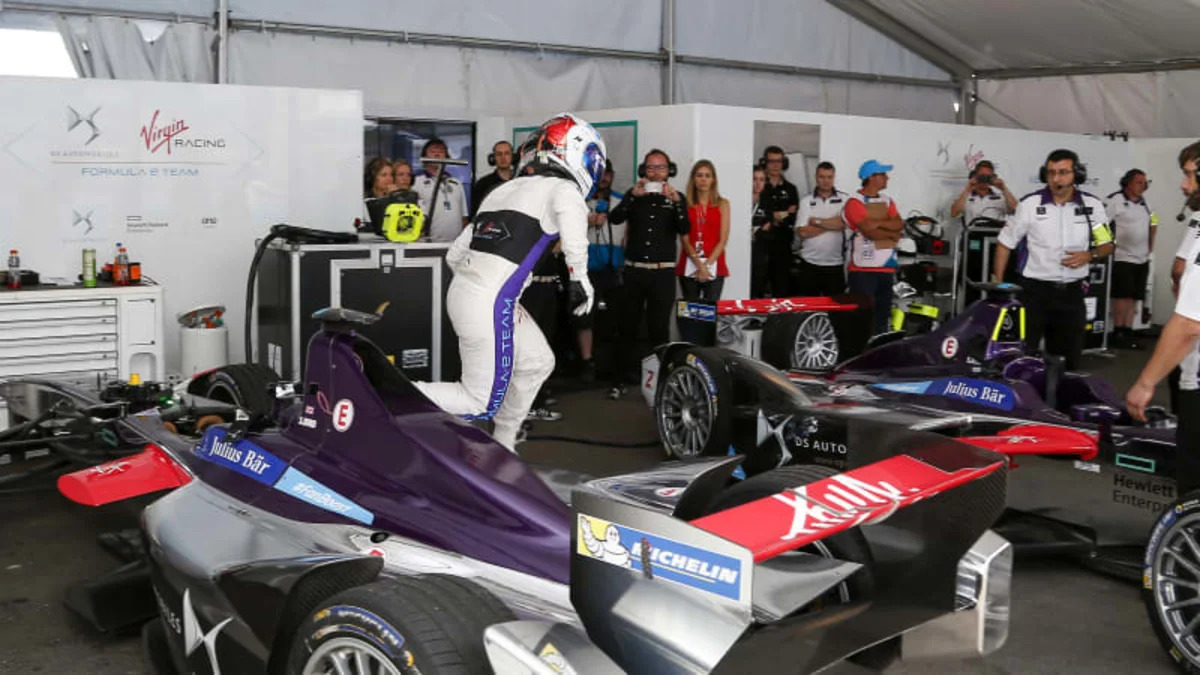While car swapping isn't new to the world of open-wheel racing, it plays a crucial role in the Formula E electric racing championship series. As the battery runs low in a racer's car, there's no time to plug in and charge. Instead, the racer pits in, and hops out of the car and into a fresh, fully charged vehicle (here's one view of what that looks like and here's another). Of course, the trick is to do it quickly and smoothly, as precious seconds can make all the difference in the outcome of the race.
Needless to say, there's a bit of an art to the Formula E car swap. First, there's deciding when to make the changeover, as each car has an imposed limit to the amount of energy it can carry. This means drivers have to ration their energy, curtailing their speed to save valuable electrons when it makes sense, and spending energy when speed is more valuable. Different variables affect this strategy, including temperature, caution flags, jockeying for position with another driver, and costly mistakes like a spin. "We take into account any issues that may result in too much energy being used," Mahindra Racing engineering chief Vin Patel tells Current E. "Then we plan ahead for any possible windows of opportunity, such as safety car stints or periods under a full course yellow."
When it's time to pit in, drivers must take care to adhere to pit lane speed limits and minimum pit times. They watch official FIA timers that start counting when the car crosses a timing line on the pit entry, and some teams install countdown clocks in conspicuous locations to help the driver stay on schedule. Two engineers are allowed to help the driver make the swap as quickly as possible, get them situated in the fresh car, then they wait for the timer to count down before the car can exit. Teams calculate exit speeds and how long it takes to reach the exit timing line to determine just how long the driver waits before speeding away.
To make sure everything goes smoothly, each team has its own strategy to car swapping, complete with guarded secrets, based in part on simulation and modeling. For all the different variables that can affect the swap, teams plan for a variety of scenarios. There's a lot of practice involved, says Patel, "Usually on Thursday and Friday evenings, as well as 'live' during free practice sessions on race day. Each of the mechanics who help the drivers have to hone their skills and tailor the process to suit each driver." You can watch Formula E driver Antonio Felix da Costa jumps between cars as he practices for tomorrow's in-race car swap tomorrow in Long Beach, California today here. Pay attention to how long it takes the engineers to strap him in once he's seated in the second car.
Eventually, car swapping in Formula E could go the way of car swapping in other race series. But until the energy density of the batteries used enables drivers to complete the entire race on a single charge, teams are going to continue to perfect their strategies in the pit.
Related Video:
Needless to say, there's a bit of an art to the Formula E car swap. First, there's deciding when to make the changeover, as each car has an imposed limit to the amount of energy it can carry. This means drivers have to ration their energy, curtailing their speed to save valuable electrons when it makes sense, and spending energy when speed is more valuable. Different variables affect this strategy, including temperature, caution flags, jockeying for position with another driver, and costly mistakes like a spin. "We take into account any issues that may result in too much energy being used," Mahindra Racing engineering chief Vin Patel tells Current E. "Then we plan ahead for any possible windows of opportunity, such as safety car stints or periods under a full course yellow."
When it's time to pit in, drivers must take care to adhere to pit lane speed limits and minimum pit times. They watch official FIA timers that start counting when the car crosses a timing line on the pit entry, and some teams install countdown clocks in conspicuous locations to help the driver stay on schedule. Two engineers are allowed to help the driver make the swap as quickly as possible, get them situated in the fresh car, then they wait for the timer to count down before the car can exit. Teams calculate exit speeds and how long it takes to reach the exit timing line to determine just how long the driver waits before speeding away.
To make sure everything goes smoothly, each team has its own strategy to car swapping, complete with guarded secrets, based in part on simulation and modeling. For all the different variables that can affect the swap, teams plan for a variety of scenarios. There's a lot of practice involved, says Patel, "Usually on Thursday and Friday evenings, as well as 'live' during free practice sessions on race day. Each of the mechanics who help the drivers have to hone their skills and tailor the process to suit each driver." You can watch Formula E driver Antonio Felix da Costa jumps between cars as he practices for tomorrow's in-race car swap tomorrow in Long Beach, California today here. Pay attention to how long it takes the engineers to strap him in once he's seated in the second car.
Eventually, car swapping in Formula E could go the way of car swapping in other race series. But until the energy density of the batteries used enables drivers to complete the entire race on a single charge, teams are going to continue to perfect their strategies in the pit.
Related Video:










Sign in to post
Please sign in to leave a comment.
Continue